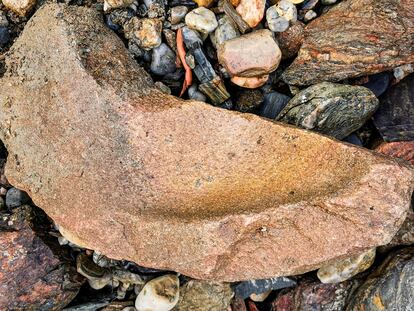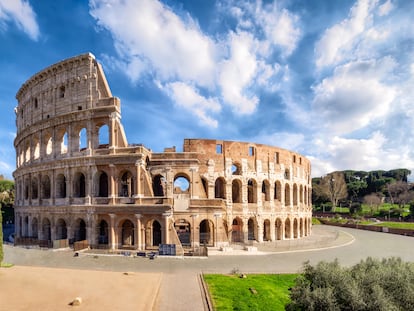Storms unearth hundreds of Roman artifacts in Spain
The collapse of a cliff in Galicia revealed pottery, bones and construction materials from two millennia ago. Meanwhile, a gallery in New York City is returning a mosaic to the same area

Between December 31 and January 1, 2023, a storm destroyed a famous fountain in Mondariz–Balneario, a spa town and municipality in Galicia, Spain. It also brought down more than 1,000 square meters of a wall called the Valença do Minho on the Portuguese border with Galicia, opening up the ground in the municipality of Nigrán.
The destruction revealed a series of treasures, which were gradually buried over the last century due to administrative disinterest and rapid modern construction along the coast.
The first person to realize that a section of cliff in Nigrán’s O Castro peninsula had collapsed was a local named Gustavo Pascual. An archeologist and high school teacher, he recognized the remnants of the Roman empire that were unearthed by the storm.
Pascual – fulfilling his New Year’s resolution – was going for a walk on the first day of January. On his way home, he noticed that a 100-foot portion of the cliff that juts out of the sea had detached as a result of the storm. He got closer to get a better look, taking a video on his phone of the piles of earth rushing towards the rocky coast.
A specialist in the artifacts of the region, it wasn’t by chance that he was the first to witness this. “My eyes always linger [on that area],” the scholar admits.
Pascual has spent years speaking about the need to conduct excavations in a small area of orchards located at the tip of the peninsula. Protected by a large ditch, this portion of O Castro is one of the few parts of the coast that has not been invaded by construction aimed at tourists, which has been ongoing since the 1970s. While the regional government of Galicia has classified the peninsula as being a town from the Iron Age, the site has never been previously researched.

Since before the pandemic, Pascual has been a member of the citizens’ group that succeeded in getting a piece of history repatriated to his town: he is a vice president of the Association for the Repatriation of the Roman Mosaic of Panxón.
Discovered in the 1800s, the mosaic, which dates from the 3rd century AD, is the only one with a marine theme ever uncovered in Galicia. For many years, archeology experts were unable to determine its whereabouts. But this changed when Gonzalo Fernández-Turégano – another member of the group – discovered the piece embedded in a table, when he was looking at a photograph in a catalog published by the Carlton Hobbs Gallery, in New York City. With the financial support of the municipal government – along with a crowdfunding campaign – the rescue operation began.
Coincidentally, while the storms were unearthing Roman history in the O Castro peninsula, the mosaic was being placed in a shipping container. Across the Atlantic, the local jewel is waiting to begin its journey to London, where – with the logistical support of the Colnaghi gallery – it will possibly be transferred to Spain by the spring.
“The collapse is as if the site wanted to attract attention: ‘Hey, I’m here too,” Pascual jokes.
Among the mud and rocks, it’s estimated that there are hundreds of remains: carved stones, roof tiles with inscriptions, fragments of pottery, animal bones and shells, and locally manufactured and imported utensils – all of it dating back around 2,000 years. The archeological deposit runs over both private land and public waters.

On the same day he walked past the unearthed artifacts, Pascual alerted the mayor, Juan González, an art history major and member of the Spanish Socialist Party. Several days later, technicians from an archeology company, who were working at another site in the municipality, arrived to make a first assessment.
The Galician Council of Cultural Heritage was also notified about the discovery, as the body responsible for authorizing future measures that must be taken to protect the hillside from rains and plundering – the latter of which began almost from the moment of discovery.
The history teacher himself, on his second visit to the landslide, discovered and stopped a man in rubber boots who was entering the already-sealed area. Pascual also realized that three of the four navicular mills that the earth had spat out had been stacked up, perhaps to eventually be discreetly loaded onto a vehicle.
The New Year’s landslide on the O Castro peninsula is the largest in living memory – but not the first. A 2010 article by archaeologist Rosa Villar and oceanographer Nicolás Villacieros noted several previous episodes, warning of the danger that the acropolis was in due to winter coastal storms and “permanent erosion,” with the ocean getting closer: “Every year, the land is uprooted by the sea, taking with it the structures and material remains,” they wrote.
The study identified five especially vulnerable areas of coastline and listed specific historical debris that could be harvested before being swallowed up by the sea. The authors also railed against the “irremediable loss of [historical] information.”
Pascual concurs: “I know of people who have materials at home, collected in recent decades.”

The ancient Roman settlement – which supposedly crossed the isthmus located between two beaches, spreading through what is now a holiday town – certainly has messages to deliver from the past. Whenever the foundation of a building is laid or whenever a net is cast, in the immediate vicinity, a Roman pot has already appeared.
From the center of Madorra beach, to the north of the O Castro peninsula, a river made of rainwater drags with it – according to Pascual – “ceramic remains” and “paleolithic material in quartzsite.” It’s all mixed with the sand; it gets trapped between recently-laid bricks.
Among all this material scattered on the sand, the historian found “the grinding wheel of a flat mill.” The earth wants to tell stories, but the sea insists on erasing its testimony.
Sign up for our weekly newsletter to get more English-language news coverage from EL PAÍS USA Edition
Tu suscripción se está usando en otro dispositivo
¿Quieres añadir otro usuario a tu suscripción?
Si continúas leyendo en este dispositivo, no se podrá leer en el otro.
FlechaTu suscripción se está usando en otro dispositivo y solo puedes acceder a EL PAÍS desde un dispositivo a la vez.
Si quieres compartir tu cuenta, cambia tu suscripción a la modalidad Premium, así podrás añadir otro usuario. Cada uno accederá con su propia cuenta de email, lo que os permitirá personalizar vuestra experiencia en EL PAÍS.
¿Tienes una suscripción de empresa? Accede aquí para contratar más cuentas.
En el caso de no saber quién está usando tu cuenta, te recomendamos cambiar tu contraseña aquí.
Si decides continuar compartiendo tu cuenta, este mensaje se mostrará en tu dispositivo y en el de la otra persona que está usando tu cuenta de forma indefinida, afectando a tu experiencia de lectura. Puedes consultar aquí los términos y condiciones de la suscripción digital.
More information
Archived In
Últimas noticias
Most viewed
- Reinhard Genzel, Nobel laureate in physics: ‘One-minute videos will never give you the truth’
- Oona Chaplin: ‘I told James Cameron that I was living in a treehouse and starting a permaculture project with a friend’
- Pablo Escobar’s hippos: A serious environmental problem, 40 years on
- Chevy Chase, the beloved comedian who was a monster off camera: ‘Not everyone hated him, just the people who’ve worked with him’
- Why we lost the habit of sleeping in two segments and how that changed our sense of time










































